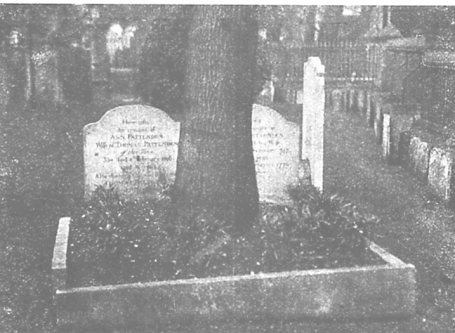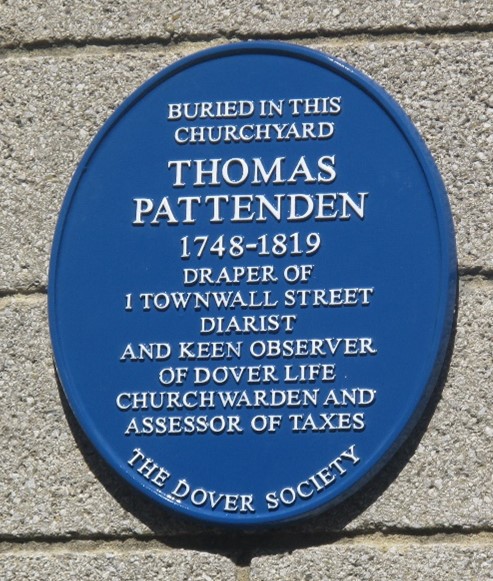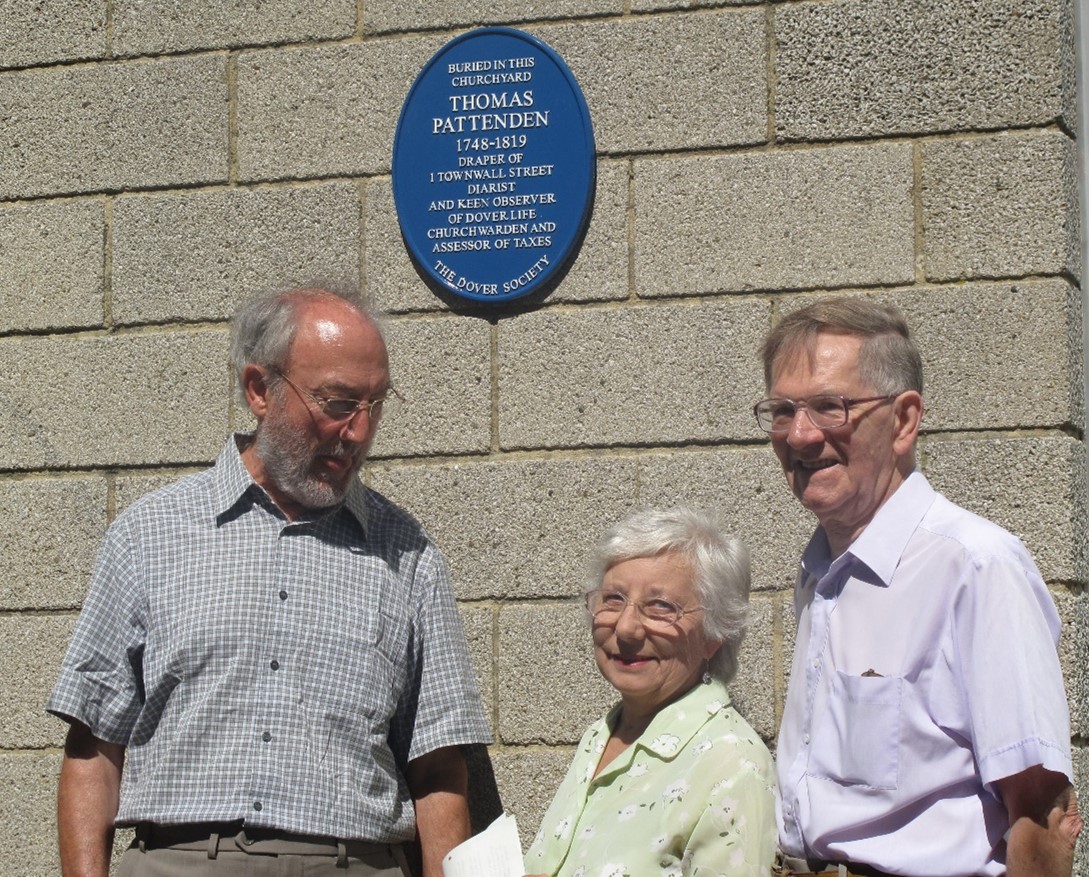Derek Leach with Kathleen and Bob Hollinsbee
The following article appeared in the Dover Society Newsletter No. 69 pages 13-15 on the unveiling of the plaque.
Thomas Pattenden
Denise Lee
At 10.30 am on Wednesday 20th July 2010, a small group of people gathered at St Mary’s Parish Centre to witness Kathleen Hollingsbee unveil the latest Dover Society plaque. This is in memory of Thomas Pattenden, 1748 to 1819, a noted local diarist and respected citizen of the town.
The opening address by Derek Leach and the unveiling speech by Kathleen Hollingsbee are reproduced here in full.
The Society chairman Derek Leach opened the proceedings as follows:
“Welcome on behalf of The Dover Society. We are here to unveil this plaque to Thomas Pattenden. Thomas who? Never heard of him, most people would say. Thomas, born in Dover in 1748, was a draper and stocking seller living at 1 Townwall Street where his wife took in children needing sea air or sea water! Why does he deserve a plaque and why here?
Thomas became one of the wealthiest and most respected men in Dover, a Freeman (by purchase), an assessor of taxes, a commissioner in the Dover Court of Requests, churchwarden and doer of good works. He was well read, sketched, (he drew the illustrations for Rev John Lyons’ History of Dover) painted, a keen gardener, collected coins and fossils, but above all was a keen observer of Dover life. For more than 20 years, beginning in 1797 when he was 55 and only ending with his death in 1819, Thomas Pattenden recorded what he called ‘daily remarks and occurrences’ about what was happening in Dover, the country and the world. Being English he always mentioned the weather!
He made careful note of ships passing Dover especially great fleets. An eye was kept on the British economy, noting in 1800 that the price of candles and soap had risen sharply because of an expected war with Russia.
During the Napoleonic wars he recorded that volunteers paraded in their scarlet uniforms on the Rope Walk and then marched with William Pitt, Lord Warden of the Cinque Ports at the time, to Maison Dieu Fields. He made drawings of the French coast for use by the military. The strengthening of Dover’s defences were recorded in detail as well as troop movements from the town. He also managed to see several sea battles from the cliff tops with the aid of his spyglass. Captured French sailors were kept in the town gaol; Thomas recorded that three of them escaped in a boat, but they were pursued and recaptured way out in the Channel despite a thick fog!
The great celebrations in Dover of Trafalgar and Waterloo are recorded. Thomas was certain that God was on England’s side and was punishing France for its wicked ways.
During these momentous times Thomas carried on his business, which sometimes took him to Canterbury. He recorded walking all the way back from Canterbury, leaving at 8am and reaching home at 6pm. When Thomas had to travel to London he either went by coach via Canterbury and Rochester or by boat from Whitstable.
Crime and punishment did not escape his notice. A debtor confined in the castle prison caused him some concern and he delivered personally a pound note from a well-wisher. Thomas gained the release of another debtor by himself paying the £8 owing. The pillory was still in use in Dover in 1800 and Thomas records the crowd pelting some unfortunate. He witnessed a riot when a great crowd demanded the release of four smugglers. Magistrates read the Riot Act and mounted troops quickly cleared the Market Square.
The diary is interspersed with unusual incidents, including the landing of a stranded whale which the public could see for 6d. Later it was cut up and boiled, producing 1000 gallons of oil. On another occasion a pig was buried in a cave by a cliff fall, but was apparently dug out six months later, still alive albeit emaciated!
Thomas recorded local sporting events, attending horse races at Priory Fields, Barham Downs and Buckland Valley as well as watching cricket matches at Northfall Meadow.
Recipes were even included to remedy whooping cough, dropsy, sore throat as well as Dr. Lewis’s recipe for making ink!
When he died, in 1819, he left a good deal of money, but his lasting legacy is his diary.
A substantial sum was left to St Mary’s for the graves of his wife and himself to be maintained, as well as for providing relief to six poor widows of husbands lost at sea. But in 1978, as part of a ‘tidying up’ by the District Council, responsible for maintaining closed churchyards, a large tree growing in the grave was removed together with the gravestones. Now there is no trace in the churchyard of this remarkable Dovorian, but today we are putting that right!
Kathleen Hollingsbee, here, has agreed to unveil our plaque. It is most appropriate that she should do it since, not only is she a knowledgeable local historian like husband Bob, but she was a member of a Kent Family History team that transcribed all the remaining, legible headstones of this churchyard in 1991. Kathleen…..”
“Thomas Pattenden cared about people and their welfare – his family, friends, colleagues, the poor and those who had suffered injustice. His diaries speak about daily life in Dover, not only its commerce, finances, the military, the navy, but about new buildings, taking tea with his friends, and what Biblical texts were used for the Sunday services at St Mary’s.
An apparently quiet and modest man he enthused over fruit and flowers in his garden at No 1 Townwall Street, exchanging plants and cuttings with his friends – and he grew some of the choicest flowers known at that time.
A large burial plot in the Northeast corner of the churchyard was used for the burial of Thomas’s parents. Thomas, a schoolmaster of Dover, buried in 1748 and Sarah, buried 1779. In 1806 the plot was used for Thomas’s own wife Ann and for Thomas himself in 1819.
In 1908 the Dover Express published a feature about him. The photograph of the grave and memorial stones in the feature show a large tree growing on the burial plot. Sometime later the tree had to be removed – in doing so the memorial stones were damaged, taken away and never replaced, despite a large sum of money he left to church for maintenance of the grave.
The site of the burial plot is this side of, and not far from the ornamental cherry tree planted in more recent times by the Queen Mother.
It must be about 100 years now since the name Pattenden disappeared from the churchyard.
Now, thanks to the efforts of the Dover Society, this plaque will remind residents and visitors of the life of this remarkable man.”
Kathleen then unveiled the plaque to warm applause.
The Dover Society would like to thank John Hill of John Hill Building Services, 125 Lewisham Road, Dover, CT17 0PA for installing the plaque free of charge. The Society also extends its thanks to everyone involved in the research, planning, and manufacture of the plaque.
 The Grave of Thomas Pattenden 1908 curtesy of the Dover Express
The Grave of Thomas Pattenden 1908 curtesy of the Dover Express
The following article appeared in The Dover Society Newsletter edition 66 pages 24 and 25. Some facts are repeated in both articles.
Thomas Pattenden – Dover’s Diarist
This is a summary by Derek Leach of an article
by A, L. Macfie in Archaeologia Cantiana Vol. 4 XCIV 1978.
For more than 20 years (1797 to 1819) Thomas Pattenden recorded interesting ‘daily remarks and occurrences’ about what was happening in Dover, the country and the world. Being English he always mentioned the weather! Thomas, born in Dover in 1748, was a draper and stocking seller living at 1 Townwall Street where his wife took in children needing sea air or seawater! Eventually Thomas became one of the wealthiest and respected men in Dover, a Freeman (by purchase), an assessor of taxes, a churchwarden and doer of good works. He was well read, sketched, painted, collected coins and fossils, but above all perhaps was a keen observer of Dover life.
In his diaries he made careful note of ships passing Dover, especially great fleets, including one that took six hours to pass. A watchful eye was kept on the British economy noting in 1797 that the Privy Council had suspended the gold standard and in 1800 that the price of candles and soap had risen sharply because of an expected war with Russia. So keen was he that he bought the three volumes of Adam Smith’s Wealth of Nations when published in 1797.
During the French wars Thomas noted the recruitment and training of volunteers for local militia service and in 1803 recorded that the volunteers paraded in their scarlet uniforms on the Rope Walk and then marched with William Pitt, Lord Warden of the Cinque Ports at the time, at their head to Maison Dieu Fields. In 1804 he made drawings of the French coast and Boulogne harbour for use by the military. Apparently, with the help of his spy glass he could even see horses ploughing on the French cliff tops, The strengthening of Dover’s defences to counter the Napoleonic threat were also recorded in detail as well as troop movements from the town. He also managed to see several sea battles from the cliff tops. Captured French sailors were kept in the town gaol; in 1808 Thomas recorded that three of them escaped in a boat, but they were pursued and recaptured way out in the Channel despite a thick fog!
The great sea and land battles of the period were also recorded, including Trafalgar and Waterloo, which were celebrated in Dover by parades, gunfire and a grand ball or supper with candles in all the house windows illuminating the town. Thomas was certain that God was on England’s side and was punishing France for its wicked ways.
During these historic times Thomas carried on his business as usual, ordering his goods from various parts of the country, including Canterbury. Occasionally he walked part of the way to the Halfway House or to Bridge. He recorded walking all the way back from Canterbury, leaving at 8am, reaching the Halfway House at 11am, where he rested for an hour, and then on to Lydden where he took tea at a friend’s house. He reached home soon after 6pm ‘and thank God met Mrs. P. again in health and safety.’ When Thomas had to travel to London he either went by coach via Canterbury and Rochester or by boat from Whitstable. This was sometimes difficult since he could reach Whitstable when a storm was raging or the wind was in the wrong direction and would be forced to return to Canterbury and travel by coach.
Crime and punishment did not escape his notice. A debtor confined in the castle prison caused him some concern and he delivered personally a pound note from a well-wisher. He notes another debtor released after four years and yet another who escaped and was sentenced to a further four years; Thomas gained his release by paying the £8 owing himself. The pillory was still in use in Dover in 1800 and Thomas records the crowd pelting some unfortunate. In 1807 he witnessed a riot when a great crowd demanded the release of four smugglers. Magistrates read the Riot Act and mounted troops quickly cleared the Market Square. Thomas also dispensed his own justice when he sacked his servant girl for stealing a pair of stockings.
The diary is interspersed with unusual incidents, including the landing of a stranded whale which the public could see for 6d. Later it was cut up and boiled producing 1000 gallons of oil. On another occasion a pig was buried in a cave by a cliff fall, but was apparently dug out six months later still alive albeit emaciated!
Thomas recorded local sporting events, attending horse races at Priory Fields, Barham Downs and Buckland Valley as well as watching cricket matches at Northfall Meadow.
Recipes to remedy ailments were also included: for whooping cough, dropsy, sore throat as well as Dr. Lewis’s recipe for making ink!
He retired from his drapery business in 1804 and his wife died two years later. Thomas sat with her during her last hours and noted, ‘At six I felt the parting pang and saw her breath for the last time, when she expired without a struggle and fell asleep…’ She was buried with her husband’s father and mother in St. Mary’s churchyard. Thomas, aged 71, joined her in 1819. During these 13 years of widowhood he still took a keen interest in life and continued to record it in his diary.
Postscript: Thomas left money for the grave to be maintained, but in 1978, as part of a ‘tidying up’ by the District Council (responsible for maintaining closed churchyards) the gravestones were removed. There followed an item in the Dover Express in memoriam page:
‘PATTENDEN – Thomas. Diarist and Freeman of Dover. Not forgotten.’



